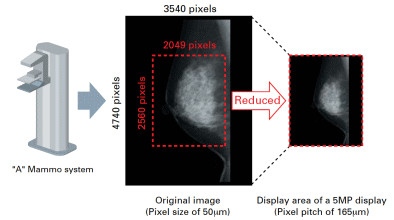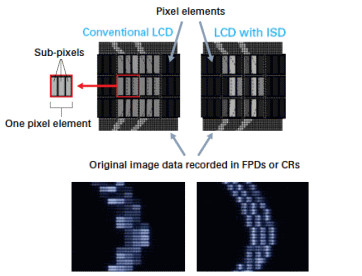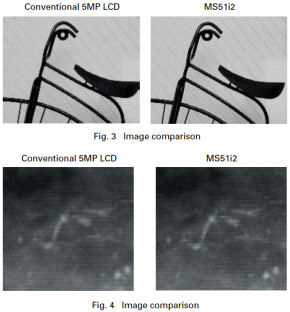ISD Technology
As imaging technology advances, modality devices are reproducing such high resolution that even current 5MP displays are unable to reproduce, creating a bottleneck in softcopy diagnostic environment. ISD (Independent Sub-pixels Drive) technology* to accept higher resolution output from modality devices as a major breakthrough.
*Patent pending
*Special viewer software is required for displaying an image.
Features
- Pixel pitch of one-third in horizontal direction (the sub-pixel chain direction) actualizes the accurate depiction of the images.
- The faithful image depiction to its original with less image degradation is realized.
- Image quality is significantly improved without changing the pixel structure of conventional displays, and it does not have any adverse impact on luminance and contrast characteristics.
Log-awaited resolution enhancement of displays:
Resolution of modality devices has already achieved a pixel size of approximately 25 to 100μm and a pixel number of 4 to 67 mega-pixels (MP). However, even 5MP displays with 165μm that can provide the current maximum resolution, still do not have enough resolution properties to meet the modality devices’ resolution.
Table1 Resolution of major mammo systems and a 5MP display
| Mammo system |
Pixel size(μm) |
Resolution |
| A |
50 |
3540 × 4740 |
| B |
25 |
7080 × 9480 |
| C |
100 |
1914 × 2294 |
| D |
70 |
2560 × 3328 |
| 5MP Display |
165 |
2048 × 2560 |
When an image is captured by a modality device, most times the native resolution is higher than the monitor is able to reproduce. Consequently, either the overall image is converted to a lowerresolution image with reduced quality, which is executed by viewer software (sub-sampling processing) or only a portion of the image is depicted with the original resolution. Fig.1 shows that the overall image is depicted on the display by only 31% of the information contained in the original image.
Fig.1 Depiction image when an original image consists of more pixels than
a display in full-screen. It is reduced to only 31% of the original.

Independent Sub-pixel Drive (ISD) technology:
A monochrome display has a large number of pixel elements and each pixel element consists of three sub-pixels, which are driven as one pixel in conventional monochrome displays. Newly developed technology, Independent Sub-pixel Drive (ISD) composed of a display that comes with the ISD algorithm and special viewer software enables each sub pixel to be driven independently, and consequently MS55i2 provides superior, lossless image reproduction.
Fig. 2 shows mechanism of resolution enhancement by the ISD and comparison of captured images on a conventional display and a display with ISD technology. By the ISD function, the image is depicted more accurately.

Improvement of image quality:
Fig. 3 and 4 show captured images on a conventional 5MP LCD and MS51i2 that was developed out of a conventional 5MP LCD with ISD technology. The depiction detail was grately improved on MS55i2 and Fig. 4 shows its excellent depiction ability of the micro calcifications, especially the edges.
Fig. 5 shows the comparison of measured MTFs of the conventional 5MP LCD and the MS55i2 that employ the same LCD panels of 5MP. As shown in the graph, the MTF of MS55i2 was improved obviously by the ISD function.
Furthermore, comparative evaluations performed by radiologists substantiated the clinical benefits of the MS55i2 over the conventional 5MP LCD.

While image quality of the medical displays such as luminance, contrast, viewing angle, and grayscale features has been improved, resolution enhancement was not actualized because of its cost.From the physical measurements and perceptual comparisons, this new resolution enhancement technology by the ISD, which actualizes excellent depiction ability inexpensively, would be very important in softcopy diagnostic environment.
![]()
![]()
![]()
![]()
![]()
![]()
![]()


